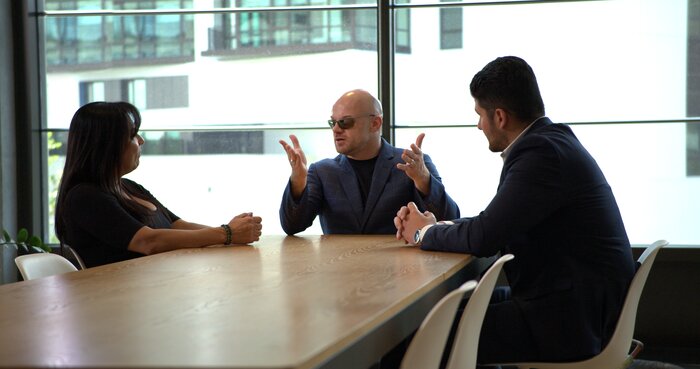The economic landscape has always been unpredictable — but right now, it’s downright volatile.
With tariffs back on the table, global trade partnerships under pressure, and President Trump’s return to the spotlight, businesses are navigating round after round of economic whiplash. Supply chains are shaking, margins are tightening, and the “safe bets” from last quarter are aging about as well as unrefrigerated milk.
So how do you lead when you don’t know what tomorrow looks like?
You build resilience — and you teach it to your teams like their careers depend on it. Because they do.
As a change keynote speaker and someone who’s literally built a billion-dollar career without eyesight, I’ve lived through blind spots, curveballs, and chaos. And I’ve learned that the leaders who consistently outperform their environment — no matter how disruptive — are the ones who stop trying to predict the future and start building the capacity to navigate it.
And if you’re leading a business through this tariff-and-trade-war economy, that message couldn’t be more relevant.
The Illusion of Control Is Over. What’s Next?
Let’s stop pretending we know what’s going to happen in Q2. Or next year. Or next week. We don’t.
Whether you’re managing manufacturing delays from a Southeast Asian supplier, rerouting logistics to dodge new tariffs, or trying to plan for a pricing strategy that won’t implode by next Friday — the name of the game isn’t control, it’s adaptability.
That’s what resilience is: a strategic advantage hiding inside a human skillset.
In times of stability, we praise consistency. In times of chaos, we pay for resilience. The leaders who thrive through disruption — the ones who don’t just survive but redefine success — are the ones who train for it. They build teams that respond, not react. That pivot, not panic. That lead, not lag.
So while some execs are obsessively doom-scrolling for clues about what Trump might do next, resilient leaders are reengineering their mindset to say: “Whatever happens, we’ll find a way through it — and probably a way to win in it.”
Opportunity Hides in Disruption (If You Know Where to Look)
Resilience isn’t just about endurance. It’s about awareness. It’s knowing that every disruption creates a gap — and in that gap, there’s an opportunity.
The companies that made billions during the pandemic weren’t the biggest or the loudest. They were the most adaptable. They saw the world shift, and instead of mourning the way things used to be, they asked: “How do we win in this version of reality?”
Leaders navigating the current tariff and trade uncertainty need to ask the same thing.
- Where are our customers getting stuck right now?
- What assumptions are we clinging to that no longer serve us?
- What skills does our team need today — not the ones we hired for 2 years ago?
- Where are our competitors panicking — and how can we build calm where they’re building chaos?
Disruption is scary. But for a sales keynote speaker like me, it’s also thrilling — because in disruption, you don’t need to be the best in the industry. You just need to be better at navigating the mess than the guy next to you.

Resilience Isn’t Motivation — It’s a System
Look, I’m not here to give you a feel-good pep talk about “hustle culture” or duct-taping your optimism to every business challenge. That’s not resilience.
Real resilience is a repeatable mental system. Here are the five pillars I teach to leaders, entrepreneurs, and organizations around the world:
-
Choose Your Response
You may not control the tariffs, the headlines, or the policy shifts. But you control your mindset. Leadership starts with choosing intentional, strategic responses instead of emotional reactions. -
Tell Yourself the Right Story
Are you a victim of this economy — or are you a visionary who can redefine success within it? The narrative you choose determines the strategy you follow. -
Visualize Greatness
Don’t plan from fear. Plan from possibility. Picture what “winning” looks like in your new landscape — and reverse-engineer it. -
Get Comfortable With Discomfort
Nothing great happens in the comfort zone. Tariffs, supply chain chaos, and policy swings aren’t the problem. The real problem is avoiding discomfort instead of leaning into it. -
Take Advantage of Disadvantages
What if the thing that seems like a limitation is actually your edge? Companies that can’t outspend their competitors need to outthink and outmaneuver them. That’s strategy. That’s resilience.
Leadership in This Climate Requires Grit and Clarity
Being a leadership keynote speaker, I’ve sat in rooms with some of the biggest names in energy, tech, finance, and manufacturing — and no matter the industry, one truth keeps coming back:
“Your team will follow your energy before they follow your strategy.”
If you’re projecting panic, your team will play small. If you’re leading with composure, they’ll step up. If you’re making excuses, so will they. But if you’re setting a standard for accountability and clarity — they’ll rise to it.
This moment in history is testing leaders in ways we haven’t seen in decades. But it’s also shaping the next wave of high-performers. You don’t get greatness without pressure. And right now? We’re all getting reps.

Final Thought: The Advantage Is Inside You
President Trump’s economic influence — whether you love him or loathe him — is forcing companies to lead through discomfort, ambiguity, and high-stakes decision-making. That’s not going away. But your ability to respond to it can evolve.
Whether you’re a CEO, a VP of sales, a front-line leader, or someone who’s trying to figure out how to steer a team through stormy weather, here’s the truth:
Resilience is the most valuable leadership skill of the next decade.
And the good news? It’s not a gift. It’s a choice. And it’s one you can make today.
If you’re looking for a change keynote speaker, a sales keynote speaker, or someone who can help your team flip uncertainty into advantage — I’ve got some stories and strategies that will make the hard times hit different.
